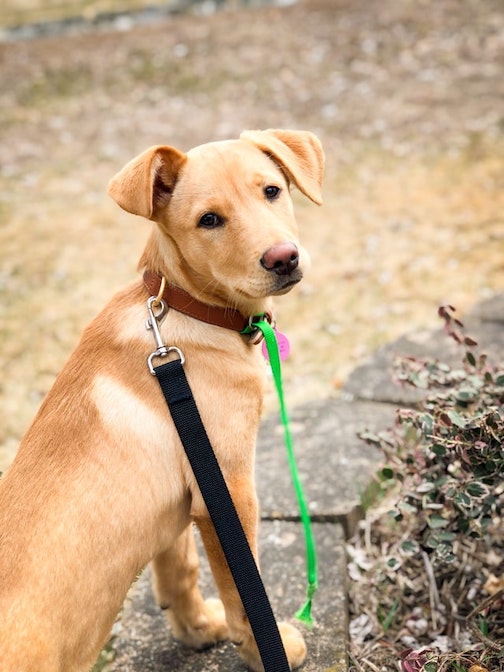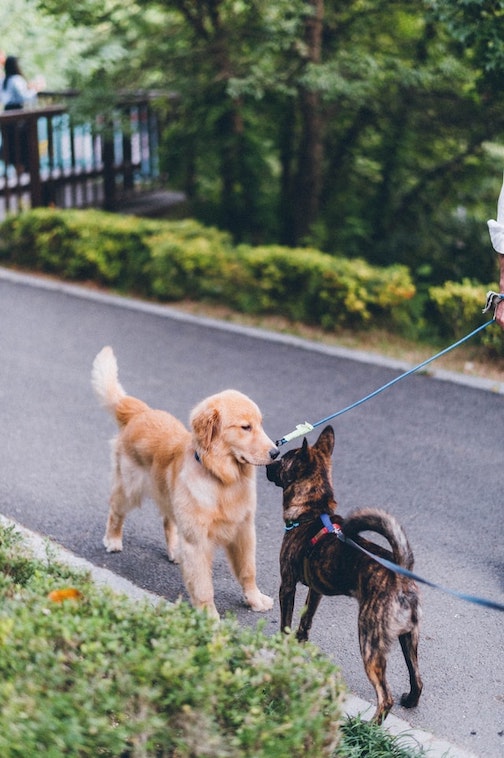Dog Leash Aggression Explained
Posted: 05/09/2023 | BY: Erin Cain | Categories: Behavior , Dog , Top Tips
One of the most common problems for dog owners is Rover going berserk whenever he’s put on a leash. Known as leash aggression, dogs often become aggressive when they’re placed on a leash. Although they’ll rarely follow through on their threat to bite, this behavior can be highly embarrassing for the owner.
Here’s what you need to know about dog leash aggression and how to stop leash aggression.

What is Leash Aggression?
Dog on leash aggression can occur due to two major reasons: frustration and fear.
When a dog is on a leash, they lose control. They become frustrated because the leash acts as a barrier to sniffing, seeing, and meeting. When they lose agency by being placed on a leash, they express this frustration through growling, lunging, and barking.
Is your dog aggressive on leash but not off? Dog leash aggression can also occur due to fear. When your dog is scared, they turn to fight or flight. If they’re unable to run or defend themselves, they will panic, which masquerades as aggression.
Puppies or dogs with a history of abuse are more likely to experience fear-based dog aggression on leash.
Signs of Dog Leash Aggression
Noticing the first signs of aggression caused by being placed on a leash is the first step to determining whether you need to invest in leash aggression training. There are a few major signs to look for, including:
- Ears are drawn back
- Cowering
- Exaggerated yawns
- Excessive vocalization
- Head is lower than back
- Licking nose or face
- Lip tension
Every dog will display different signs of aggression or fear. This is why owners need to analyze the way their dogs behave. Over time, you’ll have a firm idea of how your dog is feeling.
Causes of Leash Aggression
Fear
Typically, fear driven leash aggression is focused on other dogs and sometimes people. But fast moving cars and bicycles or skateboards can also cause a dog to become suddenly fearful and incite aggression.
Frustration
It’s not only cats that are curious, dogs are very curious of everything in their environment. Sometimes aggression starts out very innocently as a dog becomes excited and curious about something. This can quickly change to aggression, however, because the leash is holding the dog back from his goal.
Prey Drive
And finally, dogs are predatory animals and when they see prey, such as a squirrel or rabbit, they have a natural instinct to chase.
How to Stop Leash Aggression
Dog training leash aggression is the recommended course of action for how to stop leash aggression in dogs. Formal training with experts can help to socialize your canine companion.
Both forms of aggression occur due to a lack of socialization training. Your dog is either scared of other dogs or sees them as a threat and becomes aggressive.
You need to teach your pet that other dogs are neither of these things. There are numerous strategies you can implement.

Leash Aggression Tips to Follow
So, how should you go about preventing these negative behaviors? Every dog is different and may require a different combination of strategies. However, dog experts say that most canines will respond to the same corrective behaviors.
What surprises many owners is many instances of aggression are caused by their body language and behavior. Remember, your pet is highly attuned to the way you act. Changing this can alter the way your dog reacts to the presence of other canines.
Understand Dog Behavior
When owners attempt to socialize their dogs, they often approach in the same way a human would.
Forcing a dog to approach another dog head-on is a sign of aggression. Dogs will greet each other by approaching in a sideways arc before sniffing each other’s genitals. This typically lasts only a few seconds.
Avoid Punishment for Leash Aggression
Owners may respond to instances of aggression by yelling or forcing the dog to sit/lie down. Punishment is counterproductive because dogs will then associate the punishment with the negative stimulus that makes them aggressive; therefore, it compounds the problem.
Instead, move away from the trigger the moment your dog looks like they’re about to react. Create distance between themselves and the trigger.
Build Confidence Through Low Distraction Environments
It doesn’t take much to grab the attention of a dog, especially puppies. Rather than training them at a busy dog park, gradually build up their confidence through low distraction environments.
You want them to feel confident without feeling territorial. Try taking them out to different parks and streets.
Reward and Distract Through Treats
Treats are an owner’s best friend for any form of training. If a dog begins to show signs of aggression, distract them with a treat. Show them that their lack of dog leash aggression leads to a reward.
The treat game is the easiest way for your dog to associate certain behaviors with positive outcomes.
Invest in Formal Leash Aggression Training
Leash aggression training is the best way to socialize your canine. Too many owners make the mistake of inviting their friend’s dogs over to play. You need to socialize your dog with care in a controlled, neutral environment. Remember, dogs are extremely territorial.
Formal training allows the experts to take over and use their techniques to improve your dog’s behavior. They can also teach you about what you’re doing wrong and what you can do to prevent aggression going forward.
Don’t Lose Your Cool
The last thing the situation calls for is for you to become frustrated and aggressive when trying to get him to behave. Always keep in mind that your dog is not trying to annoy you or act out. He is simply having a natural reaction as a result of the situation and his upbringing. Many dogs who began life as a stray and did not have formal behavioral training when adopted will typically show some form of leash aggression.
Be sure to remain calm, confident and kind in the moment.
Conclusion
Leash training can be one of the toughest obstacles for dog owners to overcome. Rather than living in fear of coming across another dog, get your pup the professional training they need.
In the meantime, make sure they (and you) have the best protection by contacting Pet Insurance Review for a free pet health insurance quote.
DisclaimerThe information contained on this blog is intended for informational and educational purposes only and should not be construed as medical advice. It is not a substitute for professional veterinary care. Always consult with your veterinarian before making any changes to your pet's health care or treatment plan.
The authors of this blog are not veterinarians and do not claim to be experts in pet health. The information provided here is based on our own experiences and research, as well as information from reputable sources. However, we cannot guarantee the accuracy or completeness of this information.
We encourage you to do your own research and consult with your veterinarian before making any decisions about your pet's health.
Previous post
Common Chihuahua Health IssuesNext post
Spoil Your Dog This National Pet MonthCompare top pet insurance providers plans.
Enter your dog’s age in years and months to calculate their age equivalent to human years.
Calculate your dog’s ageEnter your cat’s age in years and months to calculate their age equivalent to human years.
Calculate your cat’s age